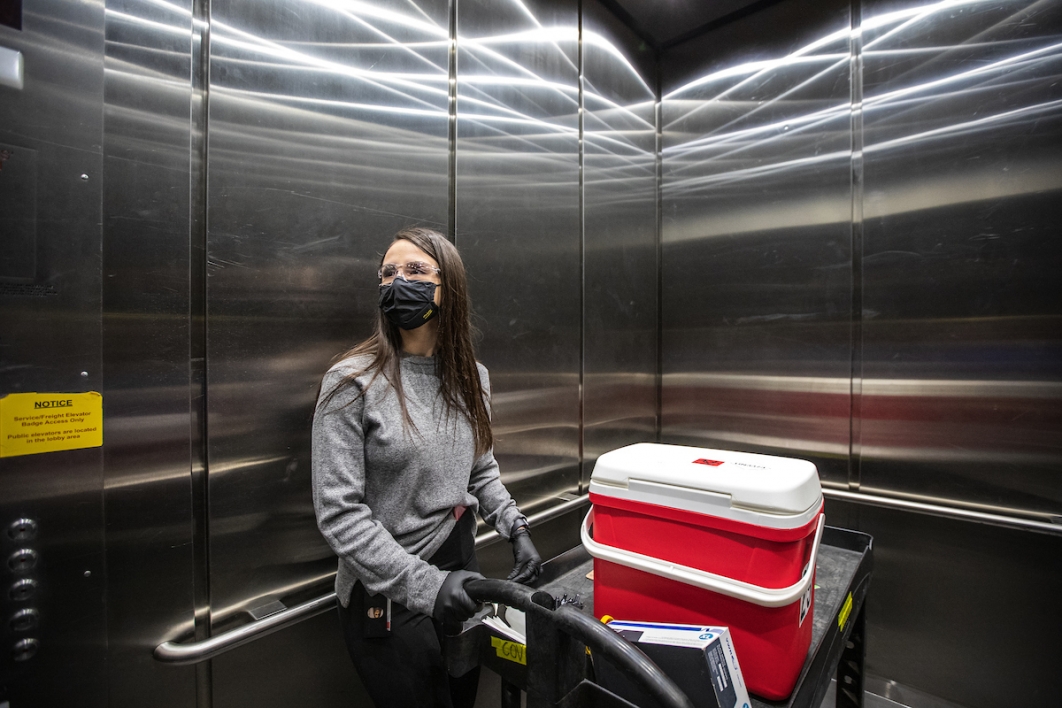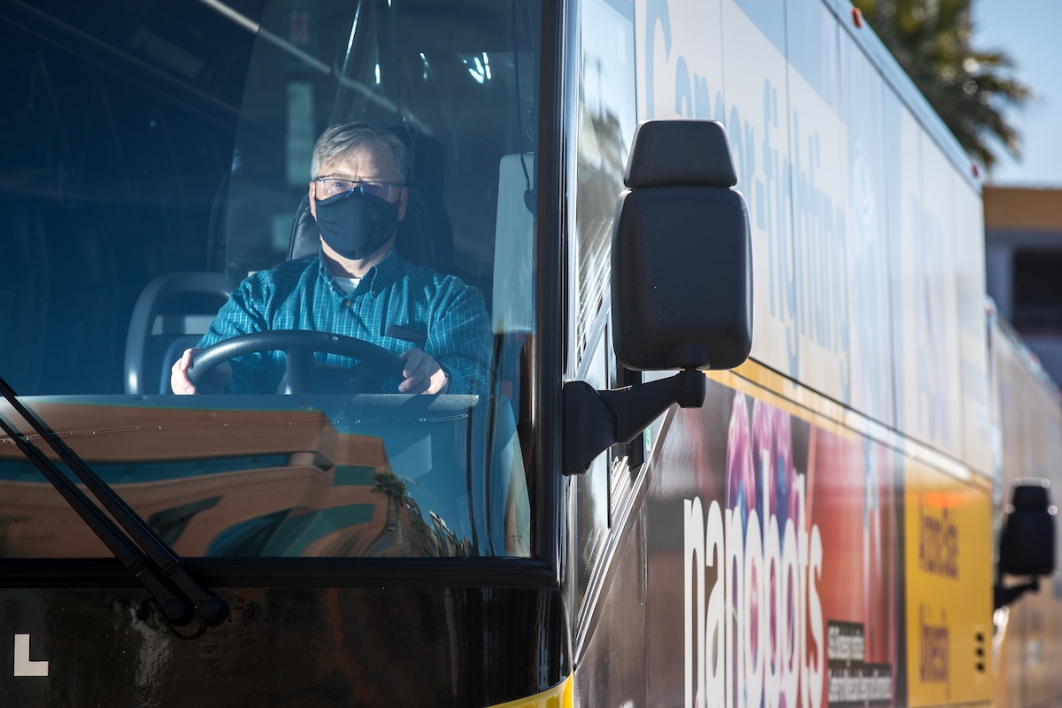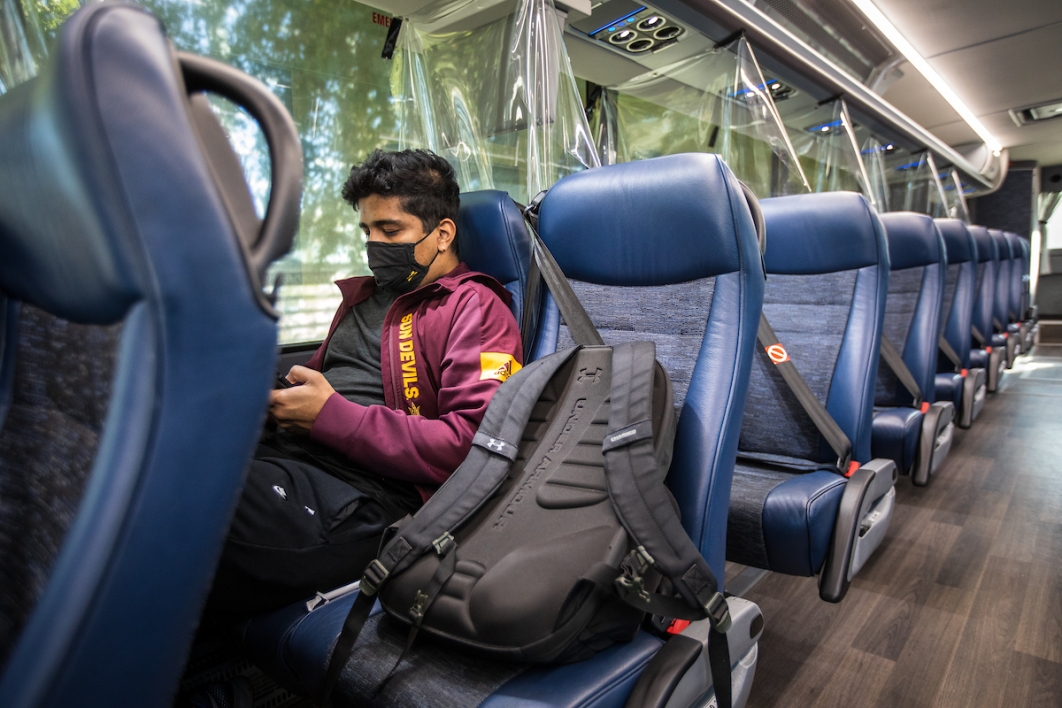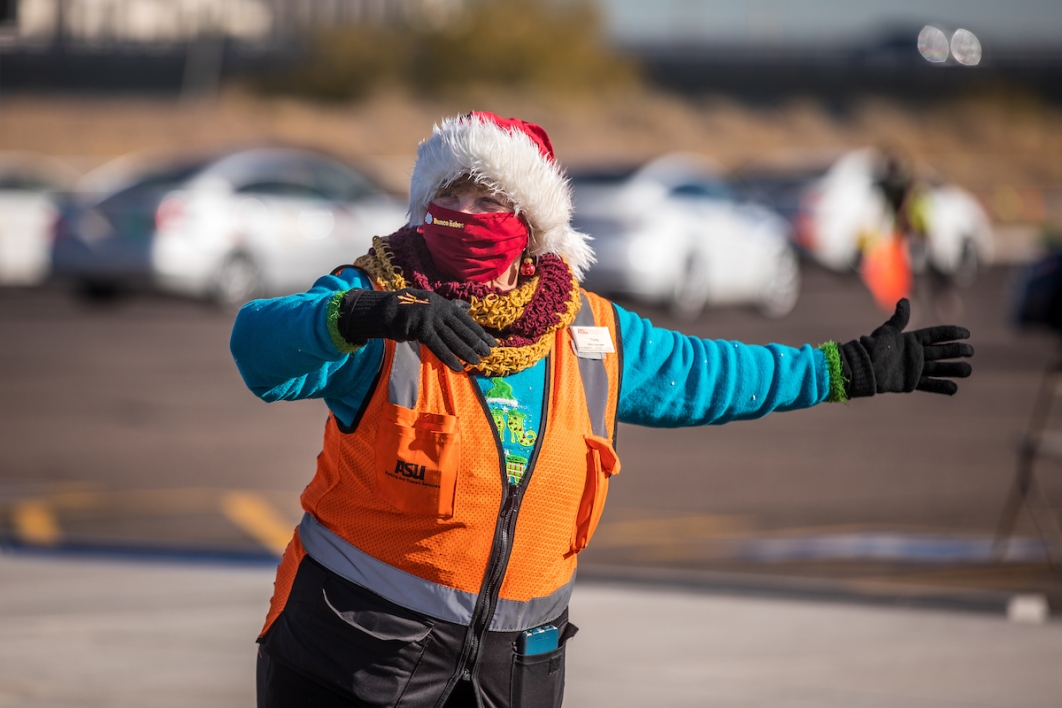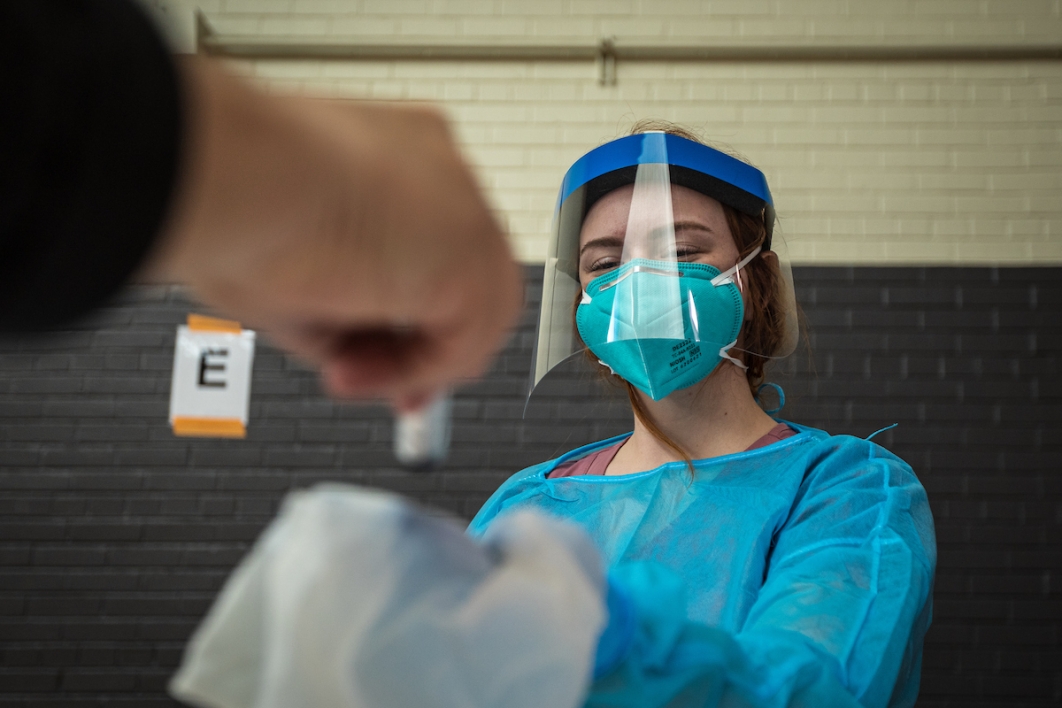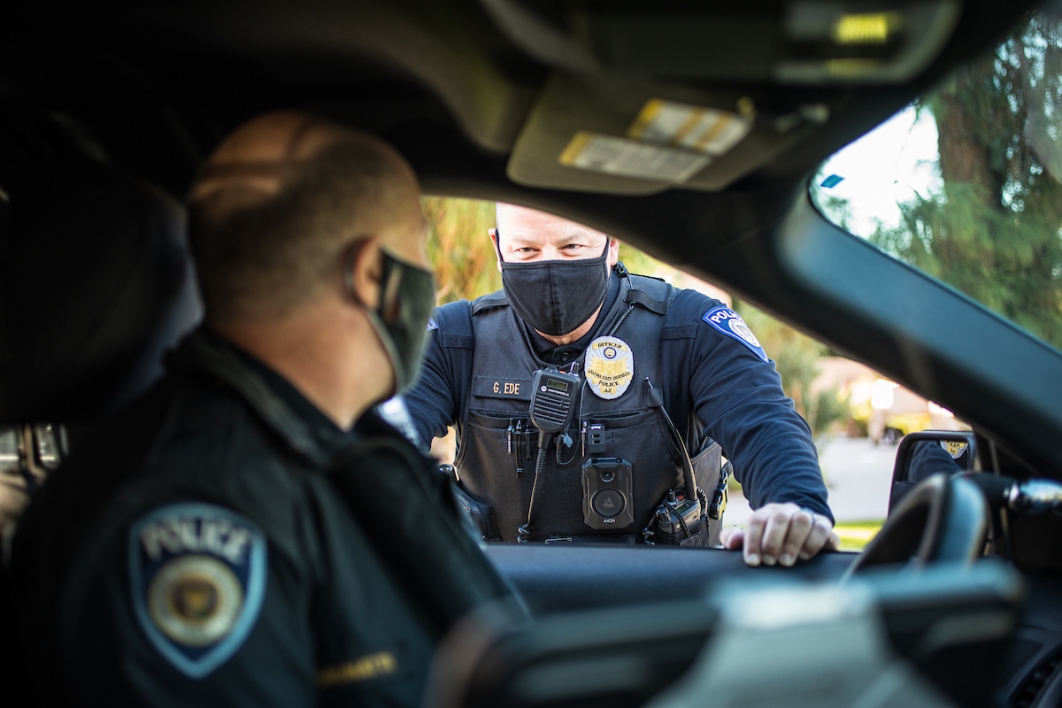Editor’s note: This story is featured in the 2021 year in review.
Everything the rest of us have tried to avoid for the past nine months – public spaces, oft-touched surfaces, contact with crowds – they have had to embrace.
They’re on one of the front lines of the COVID-19 battle. Every day since the pandemic hit, they have stepped up to keep Arizona State University's campuses running.
They come in the form of custodians, groundskeepers, bus drivers, sign makers, nurses, police officers, IT techs and parking lot attendants.
They are ASU’s unsung heroes.
“This pandemic has tested all of us in ways that we couldn’t have imagined,” said Morgan R. Olsen, ASU executive vice president, treasurer and chief financial officer. “Countless adjustments and innovations have been necessary to protect our communities, and the ASU community has been a standout example of commitment to mission and care for others. So many Sun Devils have risen to the occasion in various ways.
“One group that I think stands out is our colleagues who have been working on our campuses daily since the onset of the pandemic, almost a year ago now. Over a thousand Sun Devils have done anything and everything that has been necessary to keep our community healthy and safe, protect and maintain the university’s assets, and provide the goods and services that have allowed ASU to persevere under these challenging circumstances. As a result, they have made possible continuing student success, the advancement of new knowledge and the provision of critical services to our communities. They have my deepest admiration.”
ASU Now spent the holiday break following these employees, gathering their stories and witnessing them in action to gain a better understanding of what they do, why they do it and their hopes for the future.
Here are some of their stories:
Taking out the toxic trash
Deep within the bowels of ASU’s Biodesign Institute in a dimly lit underground dock, Alexis Ustariz is checking the contents and labeling 50-pound bins, which their department refers to as “barrels.” It’s not known to many on campus, but this is the epicenter of where the university imports all of its biohazardous materials. But it doesn’t stay there for long.
It’s Ustariz’s job, a safety technician with Environmental Health and Safety Environmental Affairs, to inspect the barrels and compile them for either re-use, incineration or permanent disposal at a landfill. They are mostly filled with discarded personal protective equipment (PPE) from several of ASU’s COVID-19 testing sites.
“I realize this is dangerous, but when you come into this field, you know you’re going to be working with toxic chemicals and radiation,” said Ustariz, who received both her master's and bachelor's degrees from ASU in environmental resource management. “Throw a pandemic on top of it, and honestly, it just adds to our knowledge of how we can react and become better.”
Her department can treat up to 250 barrels of biowaste a day, which are usually hauled away by large tractor trailers. These barrels hold items such as gloves, gowns, safety glasses and masks, as well as batteries and other discarded materials from ASU’s labs.
The job places Ustariz, a member of the San Carlos Apache Tribe, in a precarious situation. Even though she tests once a week for COVID-19, her reservation has intermittently been on lockdown for months. She hasn’t been able to see family and friends until the orders are lifted. The lockdown requires residents to stay home unless they are deemed essential workers or are seeking medical attention. Funerals are also allowed, but must be limited to two hours or less.
“I take my safety seriously, and I really don’t go anywhere or see anyone outside of work,” Ustariz said. “Going back home is not an option right now, so I choose to stay in my bubble. I have a lot of siblings – I’m one of 10 – and I miss them all. It’s a strange and scary time, but it’s not going to last forever.”
Handle with care
About 20 yards from where Ustariz performs her daily tasks sits Brittany Madril in an enclosed office. Madril is a materials handler with two years of experience under ASU’s Facilities Management.
Her job is to receive, process and distribute packages and freight that often contain biohazardous materials to various labs within the Biodesign Institute. She delivers packages such as COVID-19 saliva vials, stool samples, blood, animal cells and other items that require a delicate touch because many are time- and temperature-sensitive.
“This place is pretty much 24/7 business and we have to keep things running,” said Madril, who estimates she cleans her hands at least 20 times a day. “We can get COVID-19 from anywhere, and it’s really scary for me because my family is high risk.”
Research materials handler Brittany Madril rides a service elevator to deliver COVID-19 test samples to the labs in ASU's Biodesign Institute on Dec. 23. She has been working at ASU for two years. Photo by Charlie Leight/ASU Now
Madril, who is 21, lives at home with her parents, whom she says are high risk. She hasn't seen her extended family — who are also at risk — since the pandemic began.
Since March, she has been pulling down many hours — double in the early stages of the pandemic.
“Everybody was struggling to figure out how to deal with this situation,” said Madril, who gets tested for COVID-19 weekly. “I was working through lunch and sometimes all the way to midnight. The packages never stopped coming.”
Madril said the workload has eased over the holiday break, but the thought of living through a pandemic at her age still hits her every now and then.
“It’s not a situation that I’ve become comfortable with, but this is the lifestyle I have right now,” Madril said. “How do you deal with a situation like this because there’s no changing it until the vaccines are distributed and people get their shots? Things are happening and it’s only a matter of time. I hope we return to normal soon because I’m really missing my family.”
Buses and new beginnings
Buses got a bad rap early in the pandemic; they were deemed by media and the public as chambers for COVID-19. That mindset has changed in part due to case studies from public health officials in places such as Japan and France, who have been unable to link any outbreaks to mass transit.
That’s a big relief to Scott Duncan, Arrow Stage Line shuttle operations manager, who was hired to oversee the ASU intercampus shuttle system in 2019. Duncan also pitches in and drives whenever the need arises.
“In the beginning we were challenged to figure out what we can do to make everyone comfortable to use the bus system again,” said Duncan, who said that mobility is essential to ASU students and staff. “We’ve sat down with ASU officials and worked through a variety of options and put many new systems into place. We didn’t understand in the beginning how the virus worked or how it spread. So we felt it was very important to go above and beyond what we thought we needed to do in order to make our buses safe.”
Arrow State Lines shuttle manager Scott Duncan takes the wheel of the Gold bus before it heads out from the Tempe campus on Jan. 4 on its way to the Polytechnic campus. Photo by Charlie Leight/ASU Now
Those safety measures include hand sanitizer at the front and back of the buses; physical barriers (plastic sheets) between every row of seats; and signs preventing the use of middle seats and encouraging social distancing. They’ve capped capacity at 25%.
“We also have a fogging system that disinfects the bus every night so that it gets into every corner of the bus,” Duncan said. “That’s in addition to what the cleaners do every night, which is a thorough wipedown as part of the disinfectant process.”
Duncan said he views his three dozen drivers as real-life heroes.
“They’re out here every day and have done a tremendous job keeping our students safe and ASU operational,” Duncan said. “It’s important to make sure the pandemic doesn’t get worse or spread, but things still have to happen and continue. We are happy to be a part of that continuation process.”
Mechanical engineering graduate student Pruthviraj Vala rides in the ASU intercampus shuttle as it heads from Tempe to the Polytechnic campus on Dec. 21. Health protocols include distancing (only certain seats are open) and plastic partitions between rows. Photo by Charlie Leight/ASU Now
Dancing in a 'pink bubble'
Trudy Perez is the first to admit she doesn’t do well sitting behind a desk. She knows it, and so do her supervisors. That’s probably why they gave her a new assignment several months ago.
Perez, a customer service specialist with ASU’s Parking and Transit Services, has been directing traffic at various COVID-19 drive-thru test sites hosted by the university. And on Dec. 21, she got a little festive at a parking lot at the far north end of ASU’s Tempe campus.
On that day she sported a red traditional stocking cap, turquoise sweater, maroon and gold scarf, black gloves, bright orange traffic vest and a red “Bunco Babes” mask. She danced when not directing traffic. Her demeanor offset the seriousness of the pandemic.
“People are scared. If I can make eye contact with someone and wave even though I’m wearing a mask, then they have made contact with a friendly face and it brightens their day for a bit,” said Perez, who turned 70 in June. “I view what I do as a gift because I’m helping to educate others. And even though this is a hard time, it’s about others. You can’t be in this business unless you want to help others.”
Parking and Transit Services’ Trudy Perez directs drivers through the ASU COVID-19 test site at Lot 59N on Dec. 21 as some 630 people got tested that morning in the four hours beginning at 7 a.m. Perez is a customer service specialist and has been with the university for 20 years. Photo by Charlie Leight/ASU Now
Biodesign Institute researchers successfully created the first saliva-based COVID-19 test in the state in late May. Soon after, they began piloting the test with a network of first responders in Phoenix and expanded the test network to include students and employees. Off-campus locations, providing the tests to the public for free, launched in July.
Perez has seen and experienced a lot of things in her seven decades – wars, conflicts, recessions, double-digit inflation, tragedies, terrorist attacks – and views the pandemic no differently. She did not ignore the ugliness of 2020, but chose to focus on the more positive aspects of society.
“You know what I see? I see people being kinder and more thoughtful of other people,” Perez said. “I’ve seen people donate more, offer their place in line to someone else, little things like that. I see more humanity. But then, I live in a pink bubble. Joy is what it’s all about for me.”
The right thing in a bad time
EmmaLee Hulse is a justice studies major in The College of Liberal Arts and Sciences and has hopes of becoming an attorney. But on Dec. 21, 2020, she donned a blue gown, rubber gloves, protective eyewear and a face shield.
Hulse, a certified medical assistant, was preparing for a shift collecting saliva specimens at a COVID-19 test site inside ASU’s Sun Devil Hall on the Tempe campus. Her reason for being there may not be clear to others, but it most certainly is to her.
“I have plans to become a medical attorney, and I’m getting experience in the field so that I know what I’ll be representing,” said Hulse, who has been working as a contract employee for ASU’s Biodesign Institute for the last five months.
At 21 years old, Hulse has a lot of responsibilities on her shoulders, which includes long shifts. On this day, the site will collect close to a few hundred samples. She said ASU’s test sites must exude confidence and trust in order to run efficiently.
Third-year justice studies student and medical assistant EmmaLee Hulse demonstrates accepting a completed COVID-19 saliva test sample at Sun Devil Hall on Dec. 21. She is a contract worker and has been putting in between 30 and 40 hours a week for more than four months. Her goal with education is to practice medical law. Photo by Charlie Leight/ASU Now
“We want to project a confident image to the public that this is a friendly and safe place and that their test will go well,” Hulse said. “We try and create that environment as much as we can so that there’s a level of comfortability.”
Even though Hulse is near a lot of people who potentially have COVID-19, it’s a typical day in the life of health care workers.
“Everybody here has family at home, but they are choosing to help more people than just themselves. I think that’s so admirable,” Hulse said. “Everyone here has a different purpose. We’re here doing really good things, the right thing.”
Policing in a pandemic
Gary Ede is cruising in his police car on a nearly empty mall close to ASU’s Memorial Union. A 12-year veteran with the ASU Police Department, Ede doesn’t get to do it that often — the mall is usually full of students. But policing in a pandemic has changed the nature of his job, including driving on campus malls to do more building checks.
“The types of crimes have changed, but our jobs haven’t slowed down,” said Ede, a field training officer who works with the department’s new hires. “With less people on campus, there are less people crimes but more property theft. We have also had some issues with burglaries at the various construction sites on campus.”
Ede said the situation has made his department adjust to a shift in duties and priorities. That means more security checks on buildings, more social distancing with the public and wearing more protective gear.
ASU Police Officer Gary Ede talks about the challenges of patrolling since the coronavirus outbreak. Here, he speaks with another officer on the Tempe campus Jan. 5. He is a field training officer and has been with ASU Police for 12 years. Photo by Charlie Leight/ASU Now
Ede also limits the use of sunglasses when speaking to someone.
“We are now wearing masks and if you have sunglasses on along with the mask, communication can be difficult,” Ede said. “How you talk to someone means so much now because we’re all wearing masks and half of our faces are covered up. If you’re coming across as real stern but that’s not your intent, this can become an issue.”
Ede said he can’t wait for the pandemic to end, for life to return to normal and for students to come back en masse.
“The students just have this good energy they bring to the campus,” Ede said. “I can’t wait to get back to that good energy.”
Top photo: Safety technician Alexis Ustariz helps manage biowaste from all the ASU COVID-19 test sites by applying various disposal stickers in the loading dock of the BioDesign Institute on Dec. 23. The 50-pound bins or "barrels" contain used PPE, test tubes, straws and other waste. They are then picked up and delivered to Waste Management facilities for disposal by either incineration or sterilization and pulverization for the landfill. Ustariz recently earned her master's degree in environmental resource management and has been working at the Biodesign Institute for six months. Photo by Charlie Leight/ASU
More Science and technology

Securing America's critical minerals supply
You may never have heard of gadolinium, praseodymium or dysprosium, but you use them every day in your smartphone’s display. They are a few of the 60 elements and minerals known as “critical minerals…

James Webb Space Telescope opens new window into hidden world of dark matter
NASA’s James Webb Space Telescope (JWST) has revealed unparalleled details about the early universe: observations of young galaxies with unexpectedly elongated shapes that challenge established…

US Department of Energy selects ASU and DCX to pioneer new ways to power data centers
The U.S. Department of Energy has selected Arizona State University and DCX USA, LLC, as key research partners for its Microreactor Application Research Validation and Evaluation (MARVEL) program, an…

